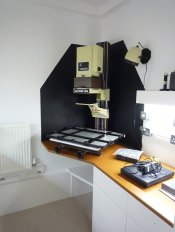When purchasing an enlarger some months back I was surprised to receive his whole darkroom when arriving to pick the enlarger up. Along with everything else came a black sack of paper weighing in at apx 35-40KG @ 3ft wide.
What I need advice on is how would you experienced guys approach such a lucky bag as this? Is there a way of grading it?
I have no idea what the finish is but his memory rumbled that it might be Kentmere/Ilford, if this helps. He was given it apx 2 years ago but never took up interest in it in favour of boxed papers.
Any help in how to classify such an unknown roll of paper would be gratefully received even if just 'use it and see'.
What I need advice on is how would you experienced guys approach such a lucky bag as this? Is there a way of grading it?
I have no idea what the finish is but his memory rumbled that it might be Kentmere/Ilford, if this helps. He was given it apx 2 years ago but never took up interest in it in favour of boxed papers.
Any help in how to classify such an unknown roll of paper would be gratefully received even if just 'use it and see'.
Last edited by a moderator:













